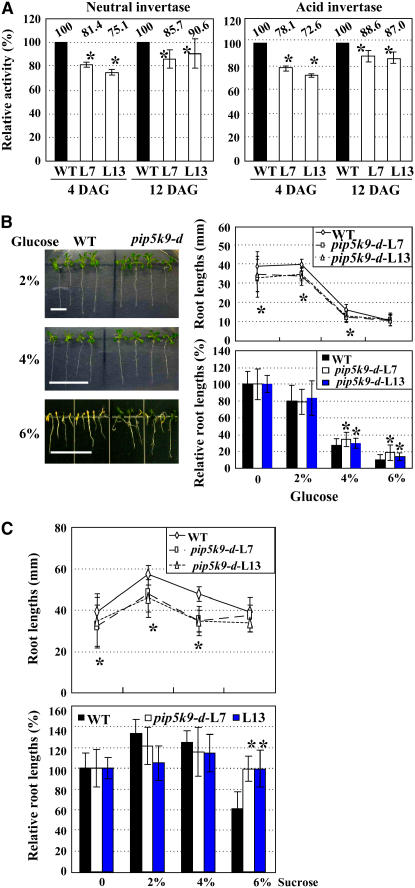Figure 5.
pip5k9-d Seedlings Were Less Sensitive to High Concentrations of Glucose and Sucrose.
(A) Both total neutral (left panel) and acid invertase (right panel) activities of pip5k9-d mutant plants were reduced compared with those of wild-type plants (which was set as 100%). The measurements were repeated three times, and average data are presented and shown as percentages. Error bars represent se. Heteroscedastic t test analysis showed significant differences (*P < 0.01). DAG, days after germination.
(B) pip5k9-d is less sensitive to high concentrations of supplemented glucose. Growth of pip5k9-d and wild-type plants on the medium supplemented with different concentrations (2, 4, or 6%) of d-glucose was observed (left panel), and root lengths were measured (right panel, top). Statistical calculation on relative root lengths compared with control seedlings without sugar (set as 100%) confirmed the reduced inhibitions of pip5k9-d seedlings (right panel, bottom). Twelve-day-old plants were used for measurements, and the experiments were repeated three times. Bar = 10 mm, and error bars represent se (n > 30). Heteroscedastic t test analysis showed significant differences (*P < 0.01).
(C) pip5k9-d is less sensitive to high concentrations of supplemented sucrose. Root lengths of pip5k9-d and wild-type plants on medium supplemented with different concentrations (2, 4, or 6%) of sucrose were measured (left panel), and relative root lengths compared with control seedlings without sucrose (set as 100%) were statistically calculated (right panel), indicating the repressed sensitivities of pip5k9-d to supplemented sucrose. Twelve-day-old plants were used for measurements, and error bars represent se (n > 30). Heteroscedastic t test analysis showed significant differences (*P < 0.01). The experiments were repeated three times.

